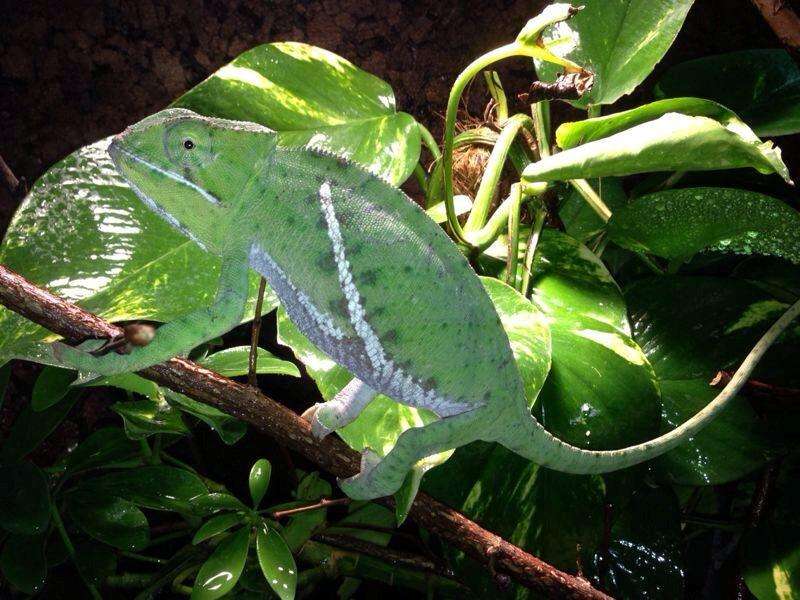Navigation
Install the app
How to install the app on iOS
Follow along with the video below to see how to install our site as a web app on your home screen.
Note: This feature may not be available in some browsers.
More options
You are using an out of date browser. It may not display this or other websites correctly.
You should upgrade or use an alternative browser.
You should upgrade or use an alternative browser.
some nice pictures....
- Thread starter kameleons jvo
- Start date
kameleons jvo
Avid Member
Motherlode Chameleon
Chameleon Enthusiast
What sized enclosure are you keeping them in Jurgen? They look as though they are flawless sub adults. This is another species I wish was not listed as an Endangered species.
Last edited:
sandrachameleon
Chameleon Enthusiast
I continue to enjoy this thread immensely
Best of luck breeding them, We would love to have some of those "baby flapnecks" sent to the US
Love it!
Jurgen, how many chameleons do you keep on average? Number of offspring in average year? This is one of my favorite threads on the internet!
this species is difficult...? can you give some informations about their care?
kameleons jvo
Avid Member
What sized enclosure are you keeping them in Jurgen? They look as though they are flawless sub adults. This is another species I wish was not listed as an Endangered species.
120 h*90 d*90 w and very densely planted
I will receive another 3.3 of these end of the month so i can build up a stable breeding group.
kameleons jvo
Avid Member
kameleons jvo
Avid Member
Best of luck breeding them, We would love to have some of those "baby flapnecks" sent to the US
hmmm very expensive flapnecks in this case
kameleons jvo
Avid Member
Love it!
Jurgen, how many chameleons do you keep on average? Number of offspring in average year? This is one of my favorite threads on the internet!
for the moment 10 species mainly calumma and furcifer,last year i had about 250 baby's and lots of work to take care of all of them
kameleons jvo
Avid Member
this species is difficult...? can you give some informations about their care?
this is one of the rarest and most wanted calumma species(and most expensive)
it took me 5 years to find these guys .
Care is very similar to parsonii they need cool and humid conditions also like parsonii a 3 month hibernation.
Incubation is 15 months with one diapause.
Its a very very shy species that i only would recommend to very very experienced calumma breeders
kameleons jvo
Avid Member
kameleons jvo
Avid Member
Niels Pedersen
Established Member
this is one of the rarest and most wanted calumma species(and most expensive)
it took me 5 years to find these guys .
Care is very similar to parsonii they need cool and humid conditions also like parsonii a 3 month hibernation.
Incubation is 15 months with one diapause.
Its a very very shy species that i only would recommend to very very experienced calumma breeders
Its NOT a Calumma species, but a Furcifer species ;-) Furcifer balteatus ;-) When that said, people once thought it was related with the parsonii group, as it has certain similarities, bodyshape, skin structure etc. F.balteatus is closer related to F.lateralis, F.major etc. then the parsonii group.
http://http://kamaeleoner.dk/artsgal...balteatus.html
Good luck with your breeding project ;-)
kameleons jvo
Avid Member
Its NOT a Calumma species, but a Furcifer species ;-) Furcifer balteatus ;-) When that said, people once thought it was related with the parsonii group, as it has certain similarities, bodyshape, skin structure etc. F.balteatus is closer related to F.lateralis, F.major etc. then the parsonii group.
http://http://kamaeleoner.dk/artsgal...balteatus.html
Good luck with your breeding project ;-)
ha ha ha ,your right Niels,i mixed up the 2 names
kameleons jvo
Avid Member
I received a new group of furcifer balteatus and 2 females are gravid

Gravid female

Uploaded with ImageShack.us
Gravid female

Uploaded with ImageShack.us
kameleons jvo
Avid Member
kameleons jvo
Avid Member
Similar threads
- Replies
- 18
- Views
- 2K
- Replies
- 1
- Views
- 434
- Replies
- 0
- Views
- 469











